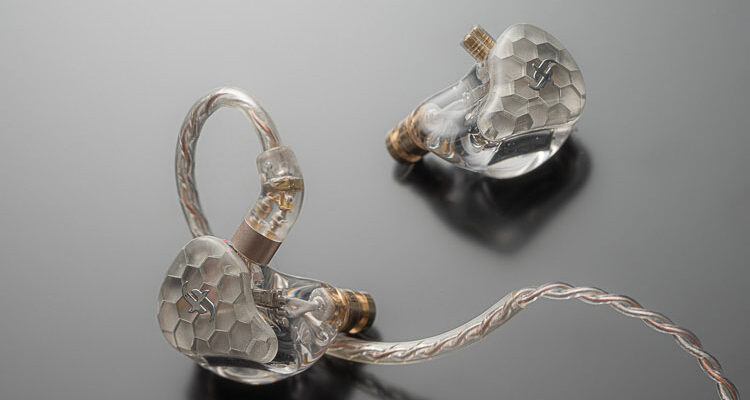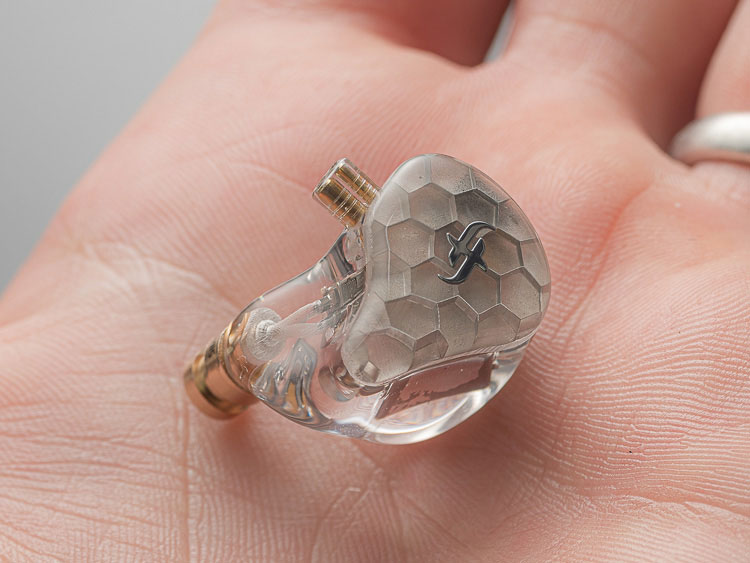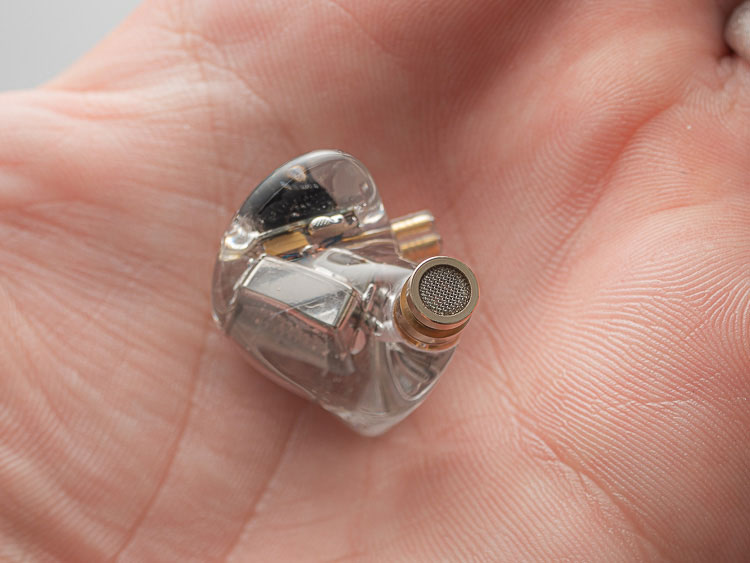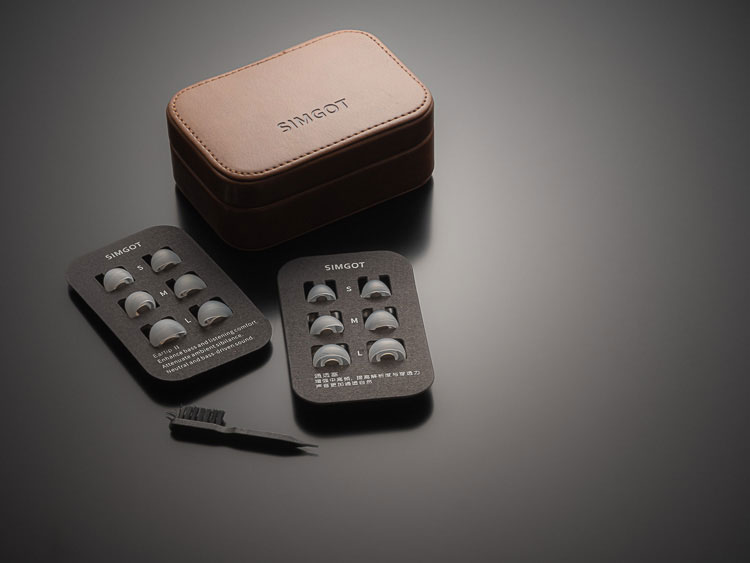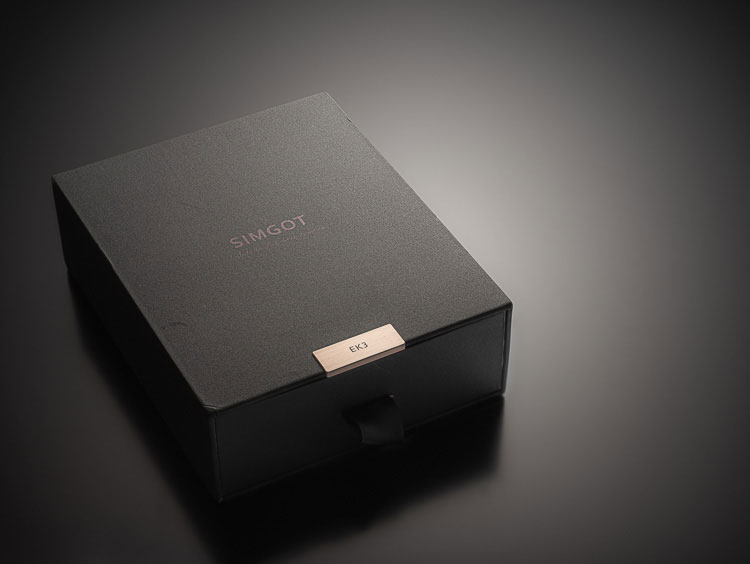The SIMGOT EK3 is a triple BA driver IEM with a uniquely tuned switch system offering up to 4 different sound signatures. It is priced at $359
Disclaimer: The SIMGOT EK3 sent to us for the purposes of this review is a sample and does not have to be returned.
Thank you to SIMGOT for giving us this opportunity.
Note, this review follows our new scoring guidelines for 2020 which you can read up on here.
Got sim? Sim’s got it. Simgot. (I made that one up myself. You can catch me at the Suck Yuks, Monday to Friday.) In case the pictures I took don’t convince, check the web; the EK3 is one of the prettiest custom-cum-universal earphones out there.
Check out its perfectly polished faceplate. Check out its beautiful honeycomb thingy under that. Check out the perfectly jutting female-cum-male two-prong connector. Check out the beautiful rubberized plug set. Let’s dig in.
Build quality
Rollover Tin HiFi and Hidizs. Simgot‘s latest rivals not only other mid-tier gear; it nearly rivals FitEar’s universals. That means pristine resin from the tragus to faceplate. That means blemish-free guts and impeccably clean internal wiring.
Okay, okay, okay- it’s all relative. I’m sure you can find cleaner shells out there. And I’ve found this blemish: between its face and body, the seams buttoning everything up are just really good. They’re not perfect. So I’ll complain. But gee-whiz, this thing is just 359$. 359$ and here and there at bit rough next to FitEar is a heavy compliment. Impressive. If you find its better, equally it will be due to luck and $$$. Bon voyage.
Design
Everything it nails indicts the market above it. Its few misses can be chalked up to corner-cutting necessity when packing such quality into such a finely tooled earphone for comparatively so little.
Sadly, the EK3 is another in an unending line of CCU earphones. As one in a legion of facsimile designs, it is resin inside, some sort of UV cured shell outside and a pretty faceplate. You’ve seen it a million times before, just maybe not in the same quality.
As impeccably battened down as it is, the EK3 is resolutely part of a growing – and boring – majority whose branding begins and ends with faceplate designs and price points. (I miss the good old days when earphone designs were unique.)
Simgot‘s two-pin flanges extrude out of its cured skins into clean and pretty firm mounting stalks. Cables go on firmly and it takes a lot of effort to again remove them. The stalk is also hella thin. Its plastic anchors to bite into resin on shallow-rooted plastic stems. I’m sure that it all joins well, but I also imagine that if anything on the EK3 will break it is this.
Comfort & Fit
Handled a Hidizs MS1/4? Handled a DM6/7? Handled a universal Jerry Harvey? Purchased someone else’s customs and been too afraid to have them re-made for your ears? If any of the above describes your experience, you’ve basically handled the EK3. Ergo, the EK3 is large, wide, and juts out of the ears. Sure, it lies pretty flat and stable in the ear. But like all CCU designs, it jams up the ears. Small ears need not apply.
You know the score.
Because it is big, the EK3 is easy to remove from and insert into your ears. Its semi-long stems are shiny and perfectly made, and their flanges hold tight earpieces well, but even some of the included tips go on a ‘kind of loose’. Its insertion angles are basically perpendicular when viewed front-on. From the top, they sit between acute and obtuse and basically hit the sweet spot.
Cable
The cable runs from the earphone at a good angle and fits securely in the ear, and, apart from curling way way way too much and being a bugger for glasses wearers, works pretty well. It also doesn’t transfer much microphonic noise to the ear. It is strong, has a good amount of stress relief, and is well machined and twists firmly into place.
The rubberized y-split and 3,5mm plug arm are all excellent quality. I guess it’s as good a time to mention it as any: the EK3’s dual pin mounts are a blast from the past. And doggone, I love them. No twisting. Much less loosening, and decent sleeves to boot. But like I said, the plastic mounting flanges may or may not be with you in the long run.
Accessories
The level of detail Simgot put into its earphones is matched by the level of detail and thought they put into their accessory set. Every piece is well labeled, organized, and formed. The earpieces are generally comfortable and suitably battened down against tearing.
The cable is tough and doesn’t allow for much touch noise. Naturally, the ‘leather’ carrying case is faux leather and the typical sort you’ve seen for yonks, but it works. Everything is held well and the set works. The box is a bit too big and wastes more space than I think is necessary, but come on, we are picking nits here as generally, Simgot nailed it.
- Penetrating silicon tips – six pair
- Balanced silicon tips – six pair
- 2-pin – 6N OCC + 2 SPC twisted cable
- Pleather carrying case
Sound Impressions
Summary
The most difficult thing to describe about a tenable earphone is its basic tone and presentation. I mean, is the EK3’s house sound its Strong Bass setting? Its Balanced Tuning setting? Exquisite Tone? Bright Vocal? Is it a composite of each one?
Here’s a punt: at base, (Exquisite and Balanced), the EK3 is pretty balanced, free of a super shiny top or bloomy or dark bass. Vocals – especially of the male persuasion – come to the fore. Mids are expansive, and stereo imaging is largely mid-centric with a deep Z-axis.
I would say that the EK3’s tuning hones to a bit of brightness, but overall it is balanced. My favorite tune setting is Exquisite Tone. It’s a bit bright in the upper mids, and balanced with a slight bump in the lower mids, giving the earphone a mustache frequency response rather than a v-shape. Sure, it is not quite as neutral as the Balanced Tuning setting, for these ears it is heaven.
Staging
One thing the EK3 delivers is deep stereo. Sure, it casts things around wide – and with nice vignetting – but it’s its Z-axis depth that really grabs you. Surely, no earphone I’ve reviewed here is as Z-axis deep. I mean, I can punch my arm pretty far into, rather than through, music that’s swirling around me. Usually, the Z-axis stops around the elbow. I’m getting way deeper than that. Heck, its depth reminds me of a top-quality dual-diaphragm earphone.
Fortunately, this depth isn’t out there on its own. The X-axis is wide, with heavy vignettes that fall a bit past the shoulders, and the Y-axis goes up a bit, though not to the heady heights of a good large-diameter dynamic driver earphone.
The cool thing about the EK3 is that immediately it hits you with width and nuanced stereo casts. You won’t listen to it now and wonder where the stereo is only to find it later as you would with the Tin HiFi P1. Splash and reverb are minimal, but in the highs, there is a bit of environmental cueing that seeps in.
Bass
Coming as it is from a large-box balanced armature, the bass is punchy, fast, but, even when set to Strong Bass mode, not super deep. It is hard and fast in the upper bass regions, but it won’t light a candle under the opening seconds to Marcus Schulz’s MainStage. Sure, it renders the deep yawns in the upper bass a few seconds later, but it won’t open like a sub-woofer straight from the get-go.
Bass tonality is coolish but integrated well into the whole.
Part of its punchiness-ness is that it generally recovers fast. But part of it is integrating well into the whole is that there is a bit of hold left in, giving it a natural skew that sometimes comes into the lower mids the way a multi-speaker setup might do to a live presentation.
Oh, and while we’re on it, the EK3 does live really well. It’s never too hot or heavy, and it provides ample environmental feedback. But it doesn’t do too much of one or the other. Bass being 95% free of bloom or wavy edges, means that fading edges, while super clean, leave a small after taste in the ear. It is so minor as to be almost subliminal. And that is great for trance, EDM, progressive, and some psychedelic rock. It’s amazing how such a small thing can do that.
Bass Switch Tweaks
Bass is elevated very slightly above the mids, but not really above the upper mids when setting to Balanced or Exquisite. In Strong Bass setting, it rises a bit more to the detriment of lower and upper mids, giving a large-valley U-shape. But even then lows aren’t massive. The EK3’s various tone settings border the mild, but do a good job within that sphere of accenting both lows and highs in step.
Coming after the Tin HiFi’s P1, I’m left with a desire for richness. The EK3 isn’t a rich-sounding earphone. Not in the bass or the highs. But its softened edges allow for a bit of contouring that isn’t possible in many balanced armature earphones.
And if you want even softer edges, put on a foam earpad. Overall, lows are generally fast, but with a bit of stick, and, while stereo goes wide and deep, bass anchors everything, warms everything, and suffuses everything with hints of warmth and minor after-echo that you don’t expect from a balanced armature earphone.
Mids and Highs
The EK3 isn’s sibilant, but cymbals at times can be sharp. I hear no strange echoes coming after ‘S sounds’. Mids are expansive, pretty rich, and evocative of certain balanced armature greats of the past. In particular, I’m thinking of the Earsonics’s SM3, which rocked my world almost ten years ago and remains a favorite today.
What rocked my world about the SM3 is how wide, and forward in a laid back way its mids were. That earphone was also so damn flat that it almost sounded like a planar. The EK3 is nowhere near as flat sounding as the SM3; likely it is programmed for neutrality at the ear rather than at the measuring rig. Because of this upper mids and highs rise above absolute neutral about as much as does bass. But the extremes rise somewhat suddenly and leave a wide, extensive, neutral plane between them. Male vocals carry forward a lot of warmth. Female vocals are free of scratch, breaking through with shiny leading edges.
There is plenty of space in the mids and upper mids, both walkthrough space and side-to-side space between and within instrument ensembles. Space, in combination with slightly bright upper mids and highs, makes for a generally bright signature. But the deep Z-axis and slight bass bloom allow in a good bit of mellow.
Matchability
The EK3 isn’t as sensitive as a Hidizs MS4 and maybe even less sensitive than a DMG DM7. This means less hiss. It also means you’ll need to bump up the volume a bit. Yes, the EK3 hisses through bad sources, but not as bad as the MS4, which is great, because earphones are to be used with a variety of output devices, and it’s a crying shame when – no matter how meagrely – they hiss through most of them.
I wish the EK3 were as insensitive to hiss as the Tin HiFi P1, but it’s not. I’m just glad that it’s not as sensitive as the Hidizs.
All of this acts like a tiny little buffer. Desktop gear will hiss less and perhaps more easily control the impedance swings of the EK3. And portable gear will still get it super loud super quick. Bonus: Simgot’s latest is better for Minidisc players than many other earphones I’ve reviewed here.
While synergy is personal, I love pitting the EK3 with the warmth of a Sharp MD-MS100 and the DAC-level programmable output of a Shanling M2X. As long as a thing has good current from its headphone out, and doesn’t hiss, it will give a great performance from the EK3. That is the problem with the Sharp. Its hiss I can stand, but bass falls off massively when driving the Simgot. Still, the two sound good together.
Select comparisons
Hidizs MS4
The MS4 is an interesting counterpoint to the EK3. Both fit similarly and are finished well. But the MS4 is even more sensitive and is much warmer. The EK3’s Z-axis gives up amazing detail along a plane the MS4 and most earphones don’t properly address. It is linear, but not rich like the MS4 and its bass, while neutral at the ear, isn’t warm or prone to bloom. There is less accent to sell it to those looking for a specific listen, but there is a nice relaxed take on V and U shaped signatures to commend it, especially if you play with the electronic filter.
BGVP DM7
Depending on the electronic filter you use, you can get the EK3 to sound quite like the DM7. Both look and fit so similarly that at a glance the two become one. At base, I prefer the EK3, but I think that the DM7’s house sound is a better fit for the long run. No need to play with filters, and a better and longer-lasting anchor point that says as much about the earphone as about the company behind it. The EK3’s filters are great but they speak of a little too much indecision on the part of the designer.
Flare Audio Flares 2 Pro
The 2 Pro is a bit more expensive and also crunchier sounding. I like both earphones, but if I could pick one to listen to now and forevermore, it would be the EK3 in Exquisite Tone mode. Of course, I much prefer the Flares 2 Pro fit and general utility. The EK3 is brilliantly made and a work of engineering art, but it is also too complicated in comparison.
Performance
The EK3 is remarkably well made, designed, and presented. Its earpieces are top-notch, and its filter system is mature and efficient. The price goes a long way. But as much as I love the EK3, I can’t help but think it is an earphone made for the indecisive by the indecisive.
I throw my full support behind its design with the proviso that indecision tends to dissolve loyalty and bonds. As such, my affair with the EK3 is interesting. I love it to bits, but I like talking about it less than I like talking about other earphones because I can’t talk about it without queuing up a bunch of filter-based provisos.
Our Verdict
Simgot bathe you in luxury for 350$. The EK3 sounds good, is built well, looks pretty cool, fits like any other CCU, and features pretty tight engineering behind its customizable sound engine. The box, the accessories, and the brand are well rounded.
While the EK3 runs the straight and narrow line where neutral sound becomes bright, it does so with poise. I wish its house sound was a bit more unique, but for what you get and at the price you get it, there’s little room to complain. I’m super stoked to see what else Simgot have up their sleeves and fully expect great things from them.
On a completely personal (and branding) note, I hope they discover a house sound around which they can turn a large array of earphones that accentuate and subvert that sound in bringing together a vocal fanbase.
EK3 Specifications
- Transducer unit – Knowles 22955, Knowles 30017
- Diaphragm – Polymer compound titanium-plated diaphragm
- Frequency response – 20Hz-40kHz
- Sensitivity – ≥115dB(at 1000Hz)
- Impedance – 14Ω -18Ω
- Distortion – <0.75% 101dB(20μpa)
- Channel imbalance – <1.5dB(at 1000Hz
- Nozzle material – aluminum oxidized nozzle
- Process material – 3D printing, medical UV curable resin
- Cable – 0.78mm 2-pin detachable silver-plated OFC

